Enjoying the seamless cuisine of rising star chef Nico Burkhardt in Stuttgart
July 6, 2012
What a great pleasure it was to dine this evening at the Steigenberger Graf Zeppelin in Stuttgart. Twenty-nine year old executive chef Nico Burkhardt took over the kitchen of the Gourmet-Restaurant Olivo just one year ago and deserves all the praise he gets.
Having earned one Michelin star already, his style can be described as “international French cuisine” as the hotel website explains, certainly “distinctively light and sophisticated”.
All I can say is that the servings in the six course meal I enjoyed were seamless from one to the next, appropriately light for the season, and the wine pairings well chosen by wine steward Sebastien Federer. Kudos also to Ana Hofman and Anja Schneider for equally seamless – and very agreeable – service.
We started things off with six amuse bouches, including a delectable mini peanut butter
sandwich with a thin slice of chicken and red wine vinegar jelly – believe me that it reminded me of my childhood, the peanut butter and jelly sandwiches in my lunch box. One of the most intriguing items was an extremely flavorful marinated olive. Perhaps out of place – I would have preferred this at the end of the meal – was a rather fun gin and tonic concoction with a piece of cucumber inside. A delicious breaded shrimp (not greasy and full of flavor) and a mini quiche were more conventional additions to this first series. Most went very well with a straightforward, uncomplicated 2009 Riesling. Dry and rather pure, just a hint of wet sock/mineral, light petrol, fine.
Then came the first main course, a fabulous combination of lightly seared tuna plus tuna carpaccio in a round shell of filo. But what proved original here was a bit of radish sorbet that perfectly matched the richness of the tuna and the accompanying, rather sweet aspect of the avocado cream. This was certainly a highlight of the meal.
And the fine tempo was maintained with the next killer combination of marinated goose foie gras combined with various red beet and apricot expressions, accompanied by a homemade toasted brioche. A perfect wine match was the Furst Rieslaner 2008 from Franken. This was about 8.5% alcohol, with fine acidity and a subtle sweetness. Certainly not as robust as a Sauternes, and that was a good thing. Because the foie gras was not heavy – somehow it came across as light! – the relative lightness of the wine matched the meal perfectly. The beet and apricot theme added a certain freshness to it all. Call it a summer foie gras serving. It worked!
We then went even lighter with a soup from fresh melon, and melon scoops, but in the centre a piece of lobster tail placed above pato negro bed, very spicy – and a nice balance to the refreshing quality of the melon. The wine was a Spanish Viogner from 2008, but it was just a touch alcoholic. Otherwise, it would have been a fine match, because the nose was rather subtle and floral.
Then came a terrific highlight of the meal: a choice filet of beef mignon, raised locally, and served with a variety of different forms of corn: from a creamy corn base at the bottom of the plate to bits of roasted corn on the cob parts. And a nice creamy potato encased in a breaded crust. Served with a jus reduction, just delicious. I enjoyed the wine combination. As food and beverage assistant manager Julien Alsoufi explained to me over the dinner, quality restaurants can gain notoriety with top wines known around the world – and Olivo serves wines like Petrus and Yquem – but they gain the most respect from serving lesser known wines. And in this case we had a grand cru red from Germany that was not… Pinot Noir.
Indeed, it was made from the lesser grape Lemberger. But it was quite good, this Schnaitmann Fellbacher Laemmler Lemberger GG 2008. The nose exuded a peppery Cote du Rhone-like charm, but the palate was better, with a rather rounded and smooth aspect that invited drinking. It had a tannic presence that balanced the richness of the meat and the corn cream and potato quite nicely.
Burkhardt uses local and seasonal ingredients, such as picking fresh herbs from a garden for the restaurant, and this also accentuates the flavors encountered. For example, they use two types of mint: one for making drinks such as Mojitos and a finer one that is used for the food servings. A pastry chef makes fresh breads, and I can say that the olive bread is one of the best I have ever tried. Two mint types, one for Mojito, one for cuisine.
We then enjoyed a series of three desserts – including a medley of strawberry, a subtle expression of coconut mixed with mango, and then a finale that looked so good, I felt bad disturbing the arrangement of coconut slices and mango with litchi ice cream and a verveine coulis.
But the evening – which started about 7 pm and ended about 10:30 pm – was not yet done. The restaurant also makes its own homemade chocolates, including dark olive and light olive within rich chocolate! Among more traditional concoctions including hazelnut cream and raspberry filling, which I also chose.
Any food and wine lover who passes through Stuttgart should pay a visit to this restaurant.

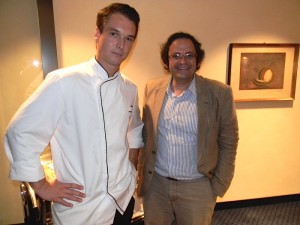
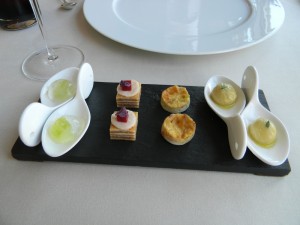
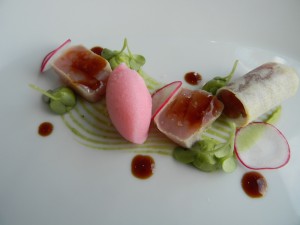
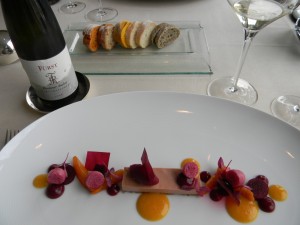

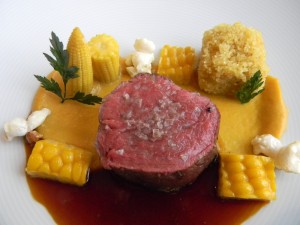
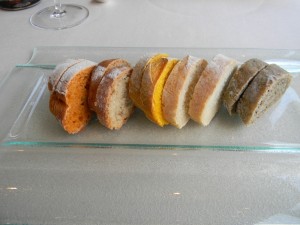
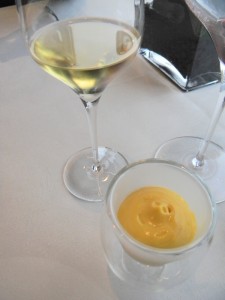


I subscribed to your rss 🙂
[…] View article: Enjoying the seamless cuisine of rising star chef Nico Burkhardt in Stuttgart […]